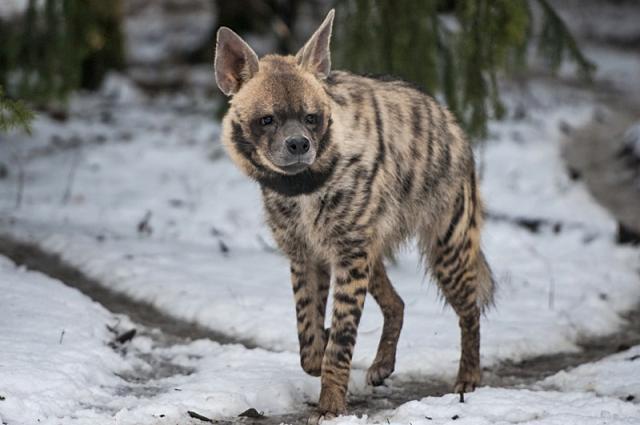The striped hyena (Hyaena hyaena) is an African native mammal that occurs in the North and East Africa. The global population of striped hyena is about 10,000 individuals. The striped hyena is the smallest of the true hyena species. It is monogamous species as the breeding animals pair for life. It is one of the hyenas that is thought to have attacked and killed children.
Striped Hyena Facts
Anatomy of Striped Hyena
- Adult hyenas have unequal lengths of forelimbs and rear limbs. The forelimbs are greater than the hind legs. It thus makes the body to lean downwards from above.
- Striped hyenas are recognized by a massive build which is set on thin and weak legs.
- It can easily move its head while the neck is almost still because of its thickness.
- They have got pointed ears and small eyes. The strong claws of hyenas are supported by the bulky pads.
- Adult hyenas weigh up to 22 to 55 kg (49 to 121 lb). The average head-body length of adults is about 85 to 130 cm (33 to 51 in).
- The tail adds 25 to 40 cm (9.8 to 15.7 in) to the length. Striped hyenas stand 60–80 cm (24–31 in) at the shoulder.
- Striped hyenas possess acute sight because they cannot rely on their weak hearing or smelling sense.
- They have got smaller skull as compared to those possessed by spotted hyenas or even brown hyenas.
- Hyenas also possess unusually long and thick fur the length of which is equal throughout the body. There is 150–225 mm long fur at the mane. But the flanks have hairs measuring up to 50 – 75 mm. It is dull brown to grey in color while the muzzle is distinguished by the black color.
- There are 5 subspecies of striped hyenas that are distributed across Africa and Asia.
See also: Hyena Facts For Kids

Range & Habitat of Striped Hyena
- Hyenas typically dig their own dens in burrows, rock fissures, and caves but sometimes they also occupy dens abandoned by aardvarks, porcupines, warthogs, and wolves. It prefers to live in rocky or open country up to an elevation of about 3,300 meters.
- The striped hyena is distributed throughout the eastern Africa, north and northeast Africa including Middle East and Arabian Peninsula. Hyena’s range extends Turkey, Turkmenistan, Afghanistan, Iraq, Uzbekistan, Georgia, Tajikistan, Iran, and Iraq. It is also found in the Indian Subcontinent.
- Some of its isolated population also occurs in Kenya, Tanzania, and Ethiopia.
Behavior of Striped Hyena
- Like typical hyenas, the striped hyena is a nocturnal animal. They are thought to leave their dens in an absolute darkness because they possess acute eyesight. Hyenas return to their dens minutes before sunrise.
- They will live in small groups containing 1 – 7 individuals.
- Striped hyenas are not territorial animals. The home range often overlaps with that of other groups.
- When foraging for food striped hyenas move in zigzag pattern at a speed of about 2 – 4 km/h.
- Hyenas living in the Serengeti occupy a home range of about 44 km2 (17 sq mi) to 72 km2 (28 sq mi).
- They are quite vocal in that hyenas produce howling or laughing voice.
Feeding Ecology & Diet of Striped Hyena
- Striped hyenas are primarily scavengers as they readily feed on carcasses of many ungulates. Hyena’s teeth are built so strong that it can easily crush even the hardest bones of the carcass leaving nothing behind.
- They also feed on the remains of zebra, impala, kongoni, topi, gazelle, and wildebeest.
- Striped hyena’s diet consists of wild boar, tortoises, porcupines, small vertebrates, and kulan. They also eat grasshoppers and fruits. Hyenas are most likely to consume carcasses from the kills of big cats such as tigers, cheetahs, caracals, and leopards.

Reproductive Biology of Striped Hyena
- In Transcaucasia, the breeding season ranges from January – February. In the southeast Turkmenia striped hyenas mate from October to November.
- The gestation period lasts 3 months. They are born blind with small ears.
- Kits have unmarked coat and they will open eyes after 7 – 8 days. They are likely to leave dens in about 30 days.
- During the broad daylight striped hyenas often hide in thick bushes, plume grass, niches, and reeds. The dens have entrances measuring 0.67–0.72 m in width.
- The estrous cycle lasts 40 – 50 days.
- They become mature at 2 – 3 years age.
- Young hyenas weigh 700 grams at birth. The mother will nurse kits for about 4 – 5 months.
- Both parents feed the young and weaning period lasts 60 days.
- The average lifespan of wild striped hyenas is about 12 years while the captive animal lives up to 23 years.
Conservation Status of Striped Hyena
Near Threatened






Leave a Reply